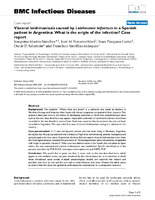Por favor, use este identificador para citar o enlazar este ítem:
http://sgc.anlis.gob.ar/handle/123456789/412| Título : | Visceral leishmaniasis caused by Leishmania infantum in a Spanish patient in Argentina: What is the origin of the infection? Case report | Autor : | Martín-Sánchez, Joaquina Navarro-Mari, José M. Pasquau-Liaño, Juan Salomón, Oscar Daniel Morillas-Márquez, Francisco |
Palabras clave : | Leishmaniasis Visceral;Leishmania infantum;Argentina;Informes de Casos | Fecha de publicación : | 2004 | Editorial : | BMC | Journal: | BMC infectious diseases | Resumen : | Background The question "Where have you been?" is a common one asked by doctors in Northern Europe and America when faced with clinical symptoms not typical of their country. This question must also arise in the clinics of developing countries in which non-autochthonous cases such as the one described here can appear. Important outbreaks of Leishmania infantum have been recorded in the last decade in several Latin American countries but its presence has not yet been recorded in Argentina. We report the first case of visceral leishmaniasis owing to L. infantum in this country. Case presentation A 71-year-old Spanish woman who has been living in Mendoza, Argentina, during the last 40 years presented with a history of high fever and shivering, anemia, leukopenia and splenomegaly over two years. Argentinian doctors did not suspect visceral leishmaniasis even when the histological analysis revealed the presence of "intracytoplasmatic spheroid particles compatible with fungal or parasitic infection". After a serious deterioration in her health, she was taken to Spain where she was evaluated and visceral leishmaniasis was established. Specific identification of the parasite was done by PCR-ELISA, isoenzyme electrophoresis and RAPD-PCR. Conclusion We would like to point out that: i) cases such as the one described here, which appear in non-endemic areas, can pass unnoticed by the clinical physician. ii) in countries in which these introduced cases reside, in-depth parasitological studies are required into vectors and possible reservoirs to rule out the rare case of local infection and, once infection has taken place, to ensure that this does not spread by anthroponotic transmission or a competent reservoir. |
Descripción : | Fil: Martín-Sánchez, Joaquina. Universidad de Granada. Departamento de Parasitología; España. Fil: Navarro-Mari, José M. Hospital Universitario Virgen de las Nieves. Servicio de Microbiología; España. Fil: Pasquau-Liaño, Juan. Hospital Universitario Virgen de las Nieves. Unidad de Enfermedades Infecciosas; Argentina. Fil: Salomón, Oscar Daniel. ANLIS Dr.C.G.Malbrán. Centro Nacional de Diagnóstico e Investigación en Endemo-Epidemias; Argentina. Fil: Morillas-Márquez, Francisco. Universidad de Granada. Departamento de Parasitología; España. |
URI : | http://sgc.anlis.gob.ar/handle/123456789/412 http://www.biomedcentral.com/content/pdf/1471-2334-4-20.pdf |
ISSN : | 1471-2334 | Derechos: | info:eu-repo/semantics/openAccess |
| Aparece en las colecciones: | snrd Publicaciones CeNDIE |
Ficheros en este ítem:
| Fichero | Descripción | Tamaño | Formato | |
|---|---|---|---|---|
| BMCInfectiousDiseases,2004,(4)20..pdf | Artículo en inglés | 246.13 kB | Adobe PDF |  Visualizar/Abrir |
Visualizaciones de página(s)
158
comprobado en 02-dic-2025
Descarga(s)
75
comprobado en 02-dic-2025
Google ScholarTM
Consultar
Los ítems de DSpace están protegidos por copyright, con todos los derechos reservados, a menos que se indique lo contrario.

